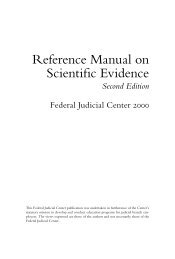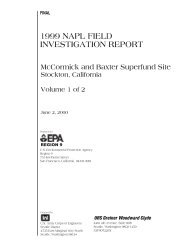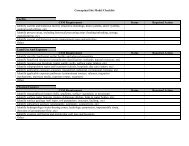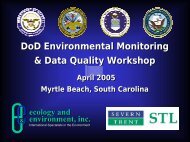Source Zone Delineation Demonstration Report - Triad Resource ...
Source Zone Delineation Demonstration Report - Triad Resource ...
Source Zone Delineation Demonstration Report - Triad Resource ...
Create successful ePaper yourself
Turn your PDF publications into a flip-book with our unique Google optimized e-Paper software.
The Wireline CPT tool is not effective at collecting soil samples below the capillary fringe, within thesaturated zone. This limits the capability of the Wireline CPT tool to investigations conducted withinthe vadose zone and the upper portion of the capillary fringe underlying the vadose zone.The Wireline CPT soil sampler utilizes 1-foot long and 1-inch diameter hollow rods to obtain a soilcore from which sample collection is facilitated from the ends of the rods. Since the soil cores cannotbe extruded from the rods for inspection, accurate geologic logging of the cores is essentiallyimpossible. Additionally, none of the traditional CPT sensor data are available in conjunction withthe Wireline CPT soil sampler. Thus, the collection of stratigraphic information during samplecollection is not possible when using the Wireline CPT soil sampler.Sample collection using the Wireline CPT soil sampler must occur from the ends of the 1-inchdiameter rods and thus, soil samples cannot be collected from geologic contacts where NAPL wouldbe expected to occur.Implementation of the technology requires an experienced Wireline CPT operator in order to conductan investigation effectively. Without an experienced operator, sample collection frequency issignificantly reduced and may result in appreciable downtime.7.1.2 SVE for CharacterizationThe SVE demonstration conducted in the suspected source zone at OU 12 focused on step tests forestimating TCE distribution within the vadose zone of the investigative area using a multiphase,multicomponent numerical model. The TCE time-series data collected during the OU 12 SVEdemonstration were compared with simulated time-series data using a theoretical distribution of TCEmass in the zone of influence and a sequential forward numerical modeling scheme in an attempt to helpdelineate source-zone contamination in the vadose zone of the investigative area. Although the step testswere optimized to assess contaminant distribution within the vadose zone of the investigative area, thedata also provide an indication of the pneumatic response of the subsurface at OU 12 during vaporextraction operations. Based on a maximum radial extent of induced subsurface vacuum of 0.01 inch ofwater, the zone of pneumatic influence observed during the OU 12 SVE demonstration ranged fromapproximately 50 to 80 feet in the southern section of the investigative area to over 100 feet in thenorthern section. The average zone of pneumatic influence within the investigative area wasapproximately 85 feet. The average in situ air permeabilities observed during vapor extraction operationsis typical of the fine-grained material in the vadose zone at OU 12 and ranged from 5 to 20 Darcy with ageometric mean of approximately 10 Darcy.Over 160 theoretical source configurations were simulated numerically during the demonstration. Thebest correlation between the predicted and measured TCE vapor-phase concentration profile was obtainedusing a theoretical TCE source located approximately 8 feet northwest of U12-VP1 and 19 feet southeastof U12-VP2. This source was assumed to be 5 feet by 5 feet in areal extent, 10 feet thick, and containing400 mg/kg TCE. For this source configuration, the predicted vapor-phase concentrations and the generalconcentration profiles were in relatively good agreement for five of the seven extraction wells butsignificant differences were observed for two wells distant from the assumed source location. In addition,the predicted TCE concentration profiles for U12-VP1 and U12-VP2 did not exhibit the characteristicexponential decline that was observed in the measured concentrations during periods of blower shutdown.March 2003 7-2 OU 12 <strong>Demonstration</strong> <strong>Report</strong>Final










